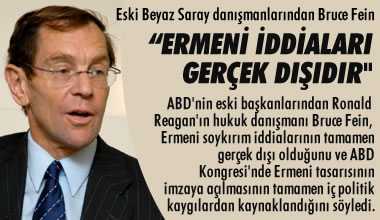When Turkey and its denialist supporters lose a battle to block the recognition of the Armenian Genocide, they resort to ridiculous attacks such as announcing their desire to impeach Pres. Biden after he is no longer in office, a laughable notion which I disclosed in my earlier article.
In another equally hopeless Turkish attempt to counter the recognition of the Armenian Genocide, Attorney Bruce Fein, Counsel for Turkish Anti-Defamation Alliance, sent a lengthy letter to members of Congress on April 24, 2023, complaining about the statement Pres. Biden had issued earlier that day.
Fein is president of the law firm Bruce Fein & Associates in Washington, D.C. Over the years, he has worn many hats to support Turkey’s campaign against the recognition of the Armenian Genocide. He has been Resident Scholar for the Turkish Coalition of America, Resident Scholar at the Assembly of Turkish American Associations, columnist for the Turkish Times newspaper, consultant to the Turkish Republic of Northern Cyprus, commentator on Turkish television, and Counsel for Turkish Anti-Defamation Alliance.
Before I delve into the content of Fein’s letter, I would like to ask two basic questions:
1) Why did Fein complain about Pres. Biden only after he recognized the Armenian Genocide on April 24? Shouldn’t he have written his letter before the President issued his statement? I don’t know if Fein got paid for his letter as Counsel for Turkish Anti-Defamation Alliance. If he did, the Turkish Alliance wasted its money.
2) Why did Fein write to Members of Congress and not to Pres. Biden directly to complain about his April 24 statement? Fein’s letter is more than three years too late. The House of Representatives recognized the Armenian Genocide on October 29, 2019 by a vote of 405 to 11, and the Senate recognized it on December 12, 2019 in a unanimous vote. Pres. Biden issued his first statement recognizing the Armenian Genocide on April 24, 2021. Where has Fein been since 2019 and 2021?
Turning to the content of Fein’s questionable letter, he shamelessly wrote that “Mr. Biden’s statement was bought and paid for by the Armenian National Committee of America (ANCA).” Since Fein provided not a shred of evidence in his defamatory letter, the ANCA has the right to sue Fein for libel. The ANCA did not even endorse Biden for President. Nevertheless, Fein went on: “But in politics, truth is helpless when assaulted by lavish campaign contributions and votes…. The Armenian genocide lie persists because of the rich backing of ANCA and their bought political toadies. It is contemptible that Pres. Biden has stooped so low.”
Fein then goes on to make a number of false statements regarding the European Court of Human Rights, the United Nations, and several scholars, such as the controversial Prof. Bernard Lewis of Princeton University who had made conflicting statements on the Armenian Genocide. He was a recipient of the Ataturk International Peace Prize. The ANCA called him “an academic mercenary.”
Here is what Wikipedia reveals about Lewis:
“The first two editions of Lewis’s The Emergence of Modern Turkey (1961 and 1968) describe the Armenian genocide as ‘the terrible holocaust of 1915, when a million and a half Armenians perished.’ In later editions, this text is altered to ‘the terrible slaughter of 1915, when, according to estimates, more than a million Armenians perished, as well as an unknown number of Turks.’ …The change in Lewis’s textual description of the Armenian genocide and his signing of the petition against the Congressional resolution was controversial among some Armenian historians as well as journalists, who suggested that Lewis was engaging in historical negationism to serve his own political and personal interests…. In a 1995 civil proceeding brought by three Armenian genocide survivors, a French court censured Lewis’ remarks under Article 1382 of the Civil Code and fined him one franc, and ordering the publication of the judgment at Lewis’ cost in Le Monde. The court ruled that while Lewis has the right to his views, their expression harmed a third party and that ‘it is only by hiding elements which go against his thesis that the defendant was able to state there was no ‘serious proof’ of the Armenian Genocide.’”
There are many other claims by Fein in his letter such as: “the Genocide Convention excludes politically motivated killings.” Thus, Fein admits that Armenians were indeed massacred, but for political reasons!
By claiming that no court verdict has been issued regarding the Armenian Genocide, Fein must have forgotten about the death sentences issued by the Turkish Military Tribunal in Istanbul in 1919 against the masterminds of the Armenian Genocide.
Fein also distorted the exile of Ottoman leaders to Malta by the British in 1919 in order to try them for their crimes. Great Britain released the 144 Turks in exchange for 22 British prisoners, stating that one British prisoner is worth a shipload of Turks.
Finally, Fein’s ‘brilliant mind’ can be demonstrated by referring to his ridiculous article published on Nov. 25, 2022, in “The Hill,” suggesting that Congress “can end the war in Ukraine … by enacting a statute withdrawing the United States from NATO”!



